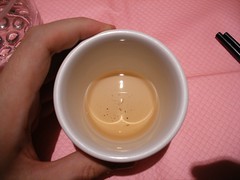June 20, 2008
Consider a spherical cup of tea
 Besides causing intoxication tea is good for inducing quick thermodynamics calculations. What kind of cup keeps the tea warm the longest?
Besides causing intoxication tea is good for inducing quick thermodynamics calculations. What kind of cup keeps the tea warm the longest?
If the cup is a cylinder with radius r and height h the total volume is V=π r2h and area A=2π(r2 + rh). If the cup is completely filled with a liquid of heat capacity C and temperature T above ambient temperature, the total heat energy is E=CTV. Energy is lost at a rate E'=kTA through the surface, where k is the heat conductivity of the cup. The temperature decrease is T' = -E'/CV, so putting it all together we get: T' = -kTA/CV = -(2k/C)[(r+h)/rh]T
The temperature loss is exponential, proportional to the the ratio of conductivity to capacity (the first factor), temperature (the last factor) and an expression depending on cup geometry. Clearly very tall and thin cups (small rh) will lose heat fast. For a given volume the smallest value of (r+h)/rh occurs when r=h/2 - a cup as tall as it is wide. Which of course makes sense since it is as close to spherical as possible.
In constructing the ultra-cup, geometry is likely one of the less important factors. The geometry term just ranges one order of magnitude or so (consider tiny 1 dl cups and big one litre cups) while the k/C ratio can range over at least three or four orders of magnitude (consider making it from metal and stone to balsa and cork). The real trick is of course to add an air layer (or vacuum) inside the cup to turn it into a thermos. This also allows a better approach towards spill-free cups with an elliptic cross section, although adding a cover of course both removes spills and heat loss.
Posted by Anders3 at June 20, 2008 01:56 PM